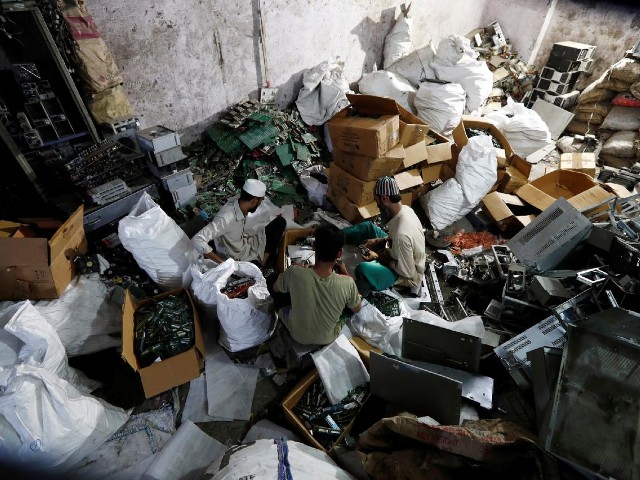
Much like the rest of the developing world, Pakistan is currently faced with the problem of electronic waste processing, which in absence of concrete policies can have severe health and environmental consequences.
Electronic waste, often known as e-waste, refers to gadgets on the verge of their useful life and destined to be refurbished, salvaged, reused, recycled or discarded. Hall Road, which is Lahore’s largest electronic market, is also home to heaps of e-waste, including broken phones, batteries, appliances, chargers and computer parts, all of which are sold for dime-a-dozen by local vendors.
A lot of this junk is specifically imported from developed countries, where it loses purpose due to legal sanctions and planned obsolescence. However, the global south offers a brimming market for these obsolete products, where they are rummaged for usable parts and sold for profit. Particularly gadgets such as old laptops, desktop computers, condensers, CD and fax machines, are in dipped in toxic chemicals to extract trace amounts of gold, silver, platinum and other precious metals stored in their circuitry while the rest is incinerated.
Various factories and warehouses propped across Lahore’s Band Road area are responsible for these extractions, but often the hazardous chemicals used in the process, along with the waste that forms, is dumped in the Ravi river via sewage.
According to Punjab Environment Protection Agency (EPA) Deputy Director Ali Ijaz, Pakistan was a signatory to the Basel Convention and ratified it on July 24, 1994. “The convention monitors the movement of toxic garbage such as e-waste. Despite environmental legislation in Punjab, we have no specific guidelines for electronic waste, which should be part of municipal solid waste but we have no rules regarding solid waste disposal. This is a problem for us,” shared the director.
According to a report by EPA, although electronic waste corresponds to only 1.4 per cent of Punjab’s normal solid waste, it can introduce up to 70 per cent heavy metals in our soil including up to 40 per cent lead.
Addressing how these chemicals can adversely affect human health, Punjab University Department of Environment Sciences Assistant Professor Dr Salman Tariq said that e-waste contains toxic substances which affect the adipose tissue in the human body. This can have a severe negative impact on fetal development and breastfeeding in mothers, while Mercury and neurotoxins found in TV screens can damage the human nervous system. Similarly, cadmium and mercury found in circuit boards and batteries, contaminate water and can prove to be carcinogenic for humans.
“A lot of these waste materials while potentially toxic, are also non-biodegradable. Such as the minerals, plastics and radioactive components used in devices and batteries, do not run out even after being buried in the ground for hundreds of years and a single cell phone battery can contaminate up to 600,000 liters of water,” Dr Tariq informed.
According to a report published by Global e-Waste Monitor in 2020, 53.6 per cent of the world's e-waste is currently being generated annually, of which only 17.4 per cent is recycled. The report further reveals that most of the electronic waste in the world is dumped in China with a volume of 10.1 per cent. Whereas, the United States is the second largest emitter of electronic waste, accounting for 6.9 per cent, followed by neighboring India, which generates 3.2 million tons of electronic waste.
However, India is the only country in South Asia where legislation has been enacted to dispose of electronic waste but it is yet to be implemented. Pakistan on the other hand is currently on ground zero, with policies in picture regarding disposal or recycling of electronic waste.
Speaking in the regard, a Lahore Waste Management Company spokesperson confirmed that they do not sort any amount of garbage collected in Lahore. “All that waste is dumped at the dumping site where our compost plants are located. Some of the waste is composted, while solid waste, which includes glass and tin bottles and lids, is disposed of. The waste left after the composting process is dumped in the ground, but there is no policy or procedure for separate disposal of electronic waste,” he told The Express Tribune.
Published in The Express Tribune, January 5th, 2022.


















COMMENTS
Comments are moderated and generally will be posted if they are on-topic and not abusive.
For more information, please see our Comments FAQ